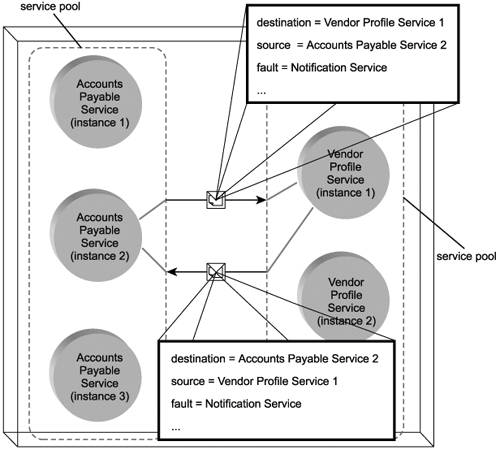Addressing
What addressing brings to SOAP messaging is much like what a waybill brings to the shipping process. Regardless of which ports, warehouses, or delivery stations a package passes through en route to its ultimate destination, with a waybill attached to it, everyone it comes into contact with knows:
- where it's coming from
- the address of where it's supposed to go
- the specific person at the address who is supposed to receive it
- where it should go if it can't be delivered as planned
The WS-Addressing specification implements these addressing features (Figure 7.2) by providing two types of SOAP headers (explained shortly). Though relatively simple in nature, these addressing extensions are integral to SOA's underlying messaging mechanics. Many other WS-* specifications implicitly rely on the use of WS-Addressing.
Figure 7.2. Addressing turns messages into autonomous units of communication.
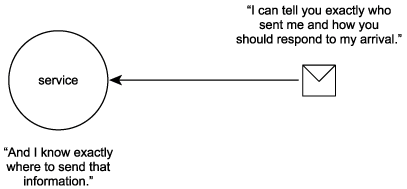
Note
For an overview of the WS-Addressing language, see the WS-Addressing language basics section in Chapter 17.
7.1.1. Endpoint references
Early on in this book we established that the loosely coupled nature of SOA was implemented through the use of service descriptions. In other words, all that is required for a service requestor to contact a service provider is the provider's WSDL definition. This document, among other things, supplies the requestor with an address at which the provider can be contacted. What if, though, the service requestor needs to send a message to a specific instance of a service provider? In this case, the address provided by the WSDL is not sufficient.
Traditional Web applications had different ways of managing and communicating session identifiers. The most common approach was to append the identifier as a query string parameter to the end of a URL. While easy to develop, this technique resulted in application designs that lacked security and were non-standardized.
The concept of addressing introduces the endpoint reference, an extension used primarily to provide identifiers that pinpoint a particular instance of a service (as well as supplementary service metadata). The endpoint reference is expected to be almost always dynamically generated and can contain a set of supplementary properties.
Figure 7.3. A SOAP message containing a reference to the instance of the service that sent it.
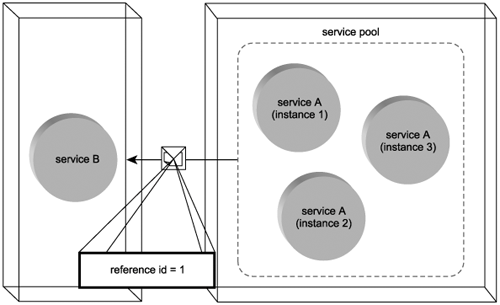
An endpoint reference consists of the following parts:
- address The URL of the Web service.
- reference properties A set of property values associated with the Web service instance. (In our previous In Plain English example, the "attention" line used in the first scenario is representative of the reference ID property.)
- reference parameters A set of parameter values that can be used to further interact with a specific service instance.
- service port type and port type Specific service interface information giving the recipient of the message the exact location of service description details required for a reply.
- policy A WS-Policy compliant policy that provides rules and behavior information relevant to the current service interaction (policies are explained later in this chapter).
Additional parts exist, which mostly identify corresponding WSDL information. With the exception of the address, all parts are optional.
7.1.2. Message information headers
In the previous chapter we covered the various primitive message exchange patterns of which complex activities are comprised. These MEPs have predictable characteristics that can ease the manner in which Web services are designed but also can limit the service interaction scenarios within which they participate.
In sophisticated service-oriented solutions, services often require the flexibility to break a fixed pattern. For example, they may want to dynamically determine the nature of a message exchange. The extensions provided by WS-Addressing were broadened to include new SOAP headers that establish message exchange-related characteristics within the messages themselves. This collection of standardized headers is known as the message information (or MI) headers (Figure 7.4).
Figure 7.4. A SOAP message with message information headers specifying exactly how the recipient service should respond to its arrival.
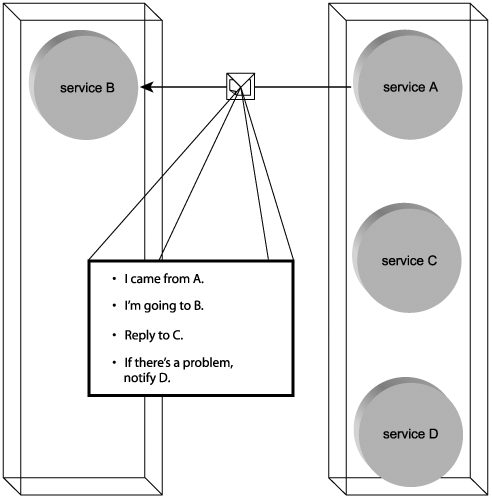
The MI headers provided by WS-Addressing include:
- destination The address to which the message is being sent.
- source endpoint An endpoint reference to the Web service that generated the message.
- reply endpoint This important header allows a message to dictate to which address its reply should be sent.
- fault endpoint Further extending the messaging flexibility is this header, which gives a message the ability to set the address to which a fault notification should be sent.
- message id A value that uniquely identifies the message or the retransmission of the message (this header is required when using the reply endpoint header).
- relationship Most commonly used in request-response scenarios, this header contains the message id of the related message to which a message is replying (this header also is required within the reply message).
- action A URI value that indicates the message's overall purpose (the equivalent of the standard SOAP HTTP action value).
(Also of interest is the fact that the WS-Addressing specification provides an anonymous URI that allows MI headers to intentionally contain an invalid address.)
Outfitting a SOAP message with these headers further increases its position as an independent unit of communication. Using MI headers, SOAP messages now can contain detailed information that defines the messaging interaction behavior of the service in receipt of the message. The net result is standardized support for the use of unpredictable and highly flexible message exchanges, dynamically creatable and therefore adaptive and responsive to runtime conditions.
7.1.3. Addressing and transport protocol independence
Historically, many of the details pertaining to how a unit of communication arrives at point B after it is transmitted from point A was left up to the individual protocols that controlled the transportation layer. While this level of technology-based abstraction is convenient for developers, it also leads to restrictions as to how communication between two units of processing logic can be achieved.
The standardized SOAP headers introduced by WS-Addressing remove much of this protocol-level dependence. These headers put the SOAP message itself in charge of its own destiny by further increasing its ability to act as a standalone unit of communication.
7.1.4. Addressing and SOA
Addressing achieves an important low-level, transport standardization within SOA, further promoting open standards that establish a level of transport technology independence (Figure 7.5). The use of endpoint references and MI headers deepens the intelligence embedded into SOAP messages, increasing message-level autonomy.
Figure 7.5. Addressing relating to other parts of SOA.
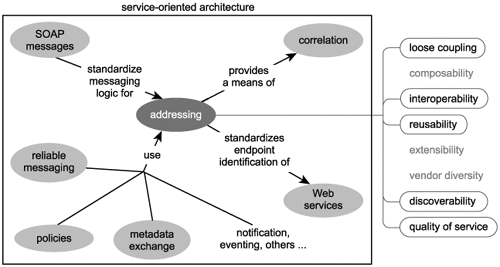
Empowering a message with the ability to self-direct its payload, as well as the ability to dictate how services receiving the message should behave, significantly increases the potential for Web services to be intrinsically interoperable. It places the task-specific logic into the message and promotes a highly reusable and generic service design standard that also facilitates the discovery of additional service metadata.
Further, the use of MI headers increases the range of interaction logic within complex activities and even encourages this logic to be dynamically determined. This, however, can be a double-edged sword. Even though MI headers can further increase the sophistication of service-oriented applications, their misuse (or overuse) can lead to some wildly creative and complex service activities.
Finally, by supporting the referencing of service instances, SOAs can be scaled in a standardized manner, without the need to resort to custom or proprietary application designs (scalability is a key QoS contribution). Having stated that, it should be pointed out that by providing functionality that enables communication with service instances, WS-Addressing indirectly supports the creation of stateful services. This runs contrary to the common service-orientation principle of statelessness (as explained in Chapter 8) and emphasizes the need for this feature to be applied in moderation.
|
SUMMARY OF KEY POINTS |
|---|
|
Introduction
- Why this book is important
- Objectives of this book
- Who this book is for
- What this book does not cover
- How this book is organized
- Additional information
Case Studies
- Case Studies
- How case studies are used
- Case #1 background: RailCo Ltd.
- Case #2 background: Transit Line Systems Inc.
Part I: SOA and Web Services Fundamentals
Introducing SOA
- Introducing SOA
- Fundamental SOA
- Common characteristics of contemporary SOA
- Common misperceptions about SOA
- Common tangible benefits of SOA
- Common pitfalls of adopting SOA
The Evolution of SOA
- The Evolution of SOA
- An SOA timeline (from XML to Web services to SOA)
- The continuing evolution of SOA (standards organizations and contributing vendors)
- The roots of SOA (comparing SOA to past architectures)
Web Services and Primitive SOA
- Web Services and Primitive SOA
- The Web services framework
- Services (as Web services)
- Service descriptions (with WSDL)
- Messaging (with SOAP)
Part II: SOA and WS-* Extensions
Web Services and Contemporary SOA (Part I: Activity Management and Composition)
- Web Services and Contemporary SOA (Part I: Activity Management and Composition)
- Message exchange patterns
- Service activity
- Coordination
- Atomic transactions
- Business activities
- Orchestration
- Choreography
Web Services and Contemporary SOA (Part II: Advanced Messaging, Metadata, and Security)
- Web Services and Contemporary SOA (Part II: Advanced Messaging, Metadata, and Security)
- Addressing
- Reliable messaging
- Correlation
- Policies
- Metadata exchange
- Security
- Notification and eventing
Part III: SOA and Service-Orientation
Principles of Service-Orientation
- Principles of Service-Orientation
- Service-orientation and the enterprise
- Anatomy of a service-oriented architecture
- Common principles of service-orientation
- How service-orientation principles inter-relate
- Service-orientation and object-orientation (Part II)
- Native Web service support for service-orientation principles
Service Layers
- Service Layers
- Service-orientation and contemporary SOA
- Service layer abstraction
- Application service layer
- Business service layer
- Orchestration service layer
- Agnostic services
- Service layer configuration scenarios
Part IV: Building SOA (Planning and Analysis)
SOA Delivery Strategies
- SOA Delivery Strategies
- SOA delivery lifecycle phases
- The top-down strategy
- The bottom-up strategy
- The agile strategy
Service-Oriented Analysis (Part I: Introduction)
- Service-Oriented Analysis (Part I: Introduction)
- Service-oriented architecture vs. Service-oriented environment
- Introduction to service-oriented analysis
- Benefits of a business-centric SOA
- Deriving business services
Service-Oriented Analysis (Part II: Service Modeling)
- Service-Oriented Analysis (Part II: Service Modeling)
- Service modeling (a step-by-step process)
- Service modeling guidelines
- Classifying service model logic
- Contrasting service modeling approaches (an example)
Part V: Building SOA (Technology and Design)
Service-Oriented Design (Part I: Introduction)
- Service-Oriented Design (Part I: Introduction)
- Introduction to service-oriented design
- WSDL-related XML Schema language basics
- WSDL language basics
- SOAP language basics
- Service interface design tools
Service-Oriented Design (Part II: SOA Composition Guidelines)
- Service-Oriented Design (Part II: SOA Composition Guidelines)
- Steps to composing SOA
- Considerations for choosing service layers
- Considerations for positioning core SOA standards
- Considerations for choosing SOA extensions
Service-Oriented Design (Part III: Service Design)
- Service-Oriented Design (Part III: Service Design)
- Service design overview
- Entity-centric business service design (a step-by-step process)
- Application service design (a step-by-step process)
- Task-centric business service design (a step-by-step process)
- Service design guidelines
Service-Oriented Design (Part IV: Business Process Design)
- Service-Oriented Design (Part IV: Business Process Design)
- WS-BPEL language basics
- WS-Coordination overview
- Service-oriented business process design (a step-by-step process)
Fundamental WS-* Extensions
- Fundamental WS-* Extensions
- You mustUnderstand this
- WS-Addressing language basics
- WS-ReliableMessaging language basics
- WS-Policy language basics
- WS-MetadataExchange language basics
- WS-Security language basics
SOA Platforms
Appendix A. Case Studies: Conclusion
EAN: 2147483647
Pages: 150
